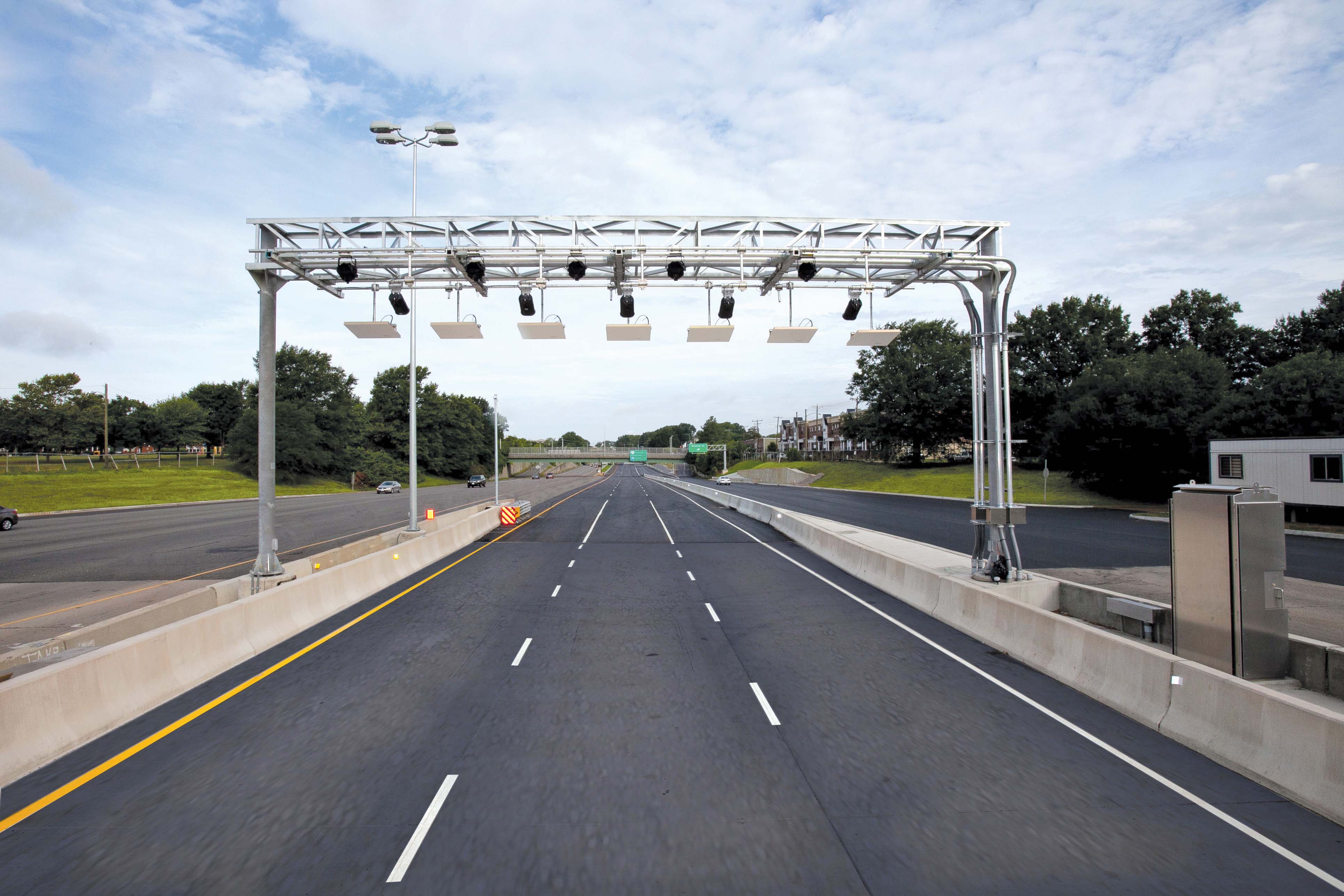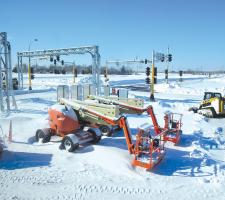
Durability and functionality in adverse weather can be evaluated
3M is investing $1.3million to expand its research center to develop and test tolling and public safety products, and customers can use it too.
When4080 3M opened its Transportation Safety Research Center (TSRC) in the 1970s it was as an extension of its research facilities. More than a showcase for innovation, the center was—and continues to be—a dynamic outdoor laboratory where new traffic materials, systems, vehicle safety and public safety products are tested in real-world conditions. Now, with 3M expanding its Motor Vehicles Systems & Services (MVSS) capabilities, $1.3 million has been invested in the facility to accommodate development and testing of the company’s All Electronic Tolling products. The improved facility is about to open and its lane level hardware includes ISO 18000 6C RFID tags, advanced multiprotocol readers, automatic license plate readers (ALPR) and automatic vehicle classification (AVC) systems as well as integration services.
“We are excited to expand the center’s capabilities to reflect our expansion in tolling and public safety products and services,” said Daniel McGurran, business director, MVSS.
“Now 3M can demonstrate its capabilities, support existing and future Toll clients, and develop and test new products. Customers can also use the facility to simulate and test systems before breaking ground on a project and train operatives before their own facility goes live.”
The center is located in 3M’s Cottage Grove Center, a few minutes from its global headquarters in Maplewood, Minn.
Located in the northern plains of the upper Midwest, Minnesota experiences hot, humid summers as well as cold and snowy winters. And since the 70s, nearly 1,000 customers have used the exclusive, dedicated facility to test solutions in real-world weather conditions.
At the heart of the TSRC is a 4km (2.5mile) roadway configured to replicate residential, urban, rural, interstate and work zone environments, allowing testing at speeds of up to 145km/h (90mph). Rain simulation is available, as is a dew deck and an asphalt test deck. The installation of ALPR products serve a dual purpose: capturing performance as well as product demonstration.
“We have all the hardware, software and systems to simulate different road and weather configurations,” said Eric Redman, 3M Toll Business Development Manager.
“Recognising that tolling is not a one-size-fits-all proposition, a customer can research more than one solution to see which best fits their requirements. So our customers don’t need to close an existing road to test potential solutions and this is a tremendous service as well as a financial and safety benefit.”
Adjacent to the roadway is the Traffic Management Facility, a two-storey building housing 3M’s advanced transportation management systems and where the upper-floor conference room overlooks the roadway.
“Researchers and visitors can observe product performance first-hand from various angles, witnessing how an idea for a tolling project can become a reality,” said Redman.
From the start the TSRC has been used for research into reflectivity, optics technology and light management, including signs and pavement markings. To test and compare sign retroreflectivity, a section of roadway approaching the TSRC’s Sign Demonstration Facility is configured as an interstate highway.
A gantry over the highway supports signs using different types of reflective sheeting and researchers can test and compare the performance of various reflective sheetings on signs, barrels, barricades, cones and removable pavement markings. Also within the TSRC is a work zone—one of the most hazardous segments of any real road system.
During the upgrade 3M’s All Electronic Tolling products and services have been woven into the facility. These include:
Future improvements considered for the TSRC include a toll management system for back office operations, as well as the installation of the company’s parking, access control and public safety products.
Coupled with the TSRC is 3M’s impressive products and research capabilities, including a staff of hundreds to handle even the most challenging toll project.
“We are not only offering toll solutions, but also access to 3M researchers and its massive range of products and services,” said Redman.
“If we don’t already have a solution in place, we can use the TSRC and researchers to come up with one.”
With the TSRC upgrade 3M believes it is well equipped to develop the next generation of innovative solutions for Departments of Transportation, Departments of Motor Vehicles, toll authorities, public safety agencies and parking operators.
When
“We are excited to expand the center’s capabilities to reflect our expansion in tolling and public safety products and services,” said Daniel McGurran, business director, MVSS.
“Now 3M can demonstrate its capabilities, support existing and future Toll clients, and develop and test new products. Customers can also use the facility to simulate and test systems before breaking ground on a project and train operatives before their own facility goes live.”
The center is located in 3M’s Cottage Grove Center, a few minutes from its global headquarters in Maplewood, Minn.
Located in the northern plains of the upper Midwest, Minnesota experiences hot, humid summers as well as cold and snowy winters. And since the 70s, nearly 1,000 customers have used the exclusive, dedicated facility to test solutions in real-world weather conditions.
At the heart of the TSRC is a 4km (2.5mile) roadway configured to replicate residential, urban, rural, interstate and work zone environments, allowing testing at speeds of up to 145km/h (90mph). Rain simulation is available, as is a dew deck and an asphalt test deck. The installation of ALPR products serve a dual purpose: capturing performance as well as product demonstration.
“We have all the hardware, software and systems to simulate different road and weather configurations,” said Eric Redman, 3M Toll Business Development Manager.
“Recognising that tolling is not a one-size-fits-all proposition, a customer can research more than one solution to see which best fits their requirements. So our customers don’t need to close an existing road to test potential solutions and this is a tremendous service as well as a financial and safety benefit.”
Adjacent to the roadway is the Traffic Management Facility, a two-storey building housing 3M’s advanced transportation management systems and where the upper-floor conference room overlooks the roadway.
“Researchers and visitors can observe product performance first-hand from various angles, witnessing how an idea for a tolling project can become a reality,” said Redman.
From the start the TSRC has been used for research into reflectivity, optics technology and light management, including signs and pavement markings. To test and compare sign retroreflectivity, a section of roadway approaching the TSRC’s Sign Demonstration Facility is configured as an interstate highway.
A gantry over the highway supports signs using different types of reflective sheeting and researchers can test and compare the performance of various reflective sheetings on signs, barrels, barricades, cones and removable pavement markings. Also within the TSRC is a work zone—one of the most hazardous segments of any real road system.
During the upgrade 3M’s All Electronic Tolling products and services have been woven into the facility. These include:
- High performance multiprotocol Automatic Vehicle Identification (AVI) readers that read the top six US protocols used by transponders for electronic fee collection at high speeds. The readers are designed specifically for road segment monitoring across single or multiple lanes and for all weather and traffic conditions.
- Fixed ALPR systems— infrared cameras, illuminator and processor contained within a single sealed enclosure—designed for the continuous monitoring of high traffic areas to alert agencies when captured plates match those found on hotlists.
- 3M’s AVC systems to identify and classify vehicles, including the number of axles, at highway speeds.
- Two-lane controllers that trigger the ALPR cameras, AVI and AVC systems to capture passing vehicles. These controllers also process the data from the AVC system.
Future improvements considered for the TSRC include a toll management system for back office operations, as well as the installation of the company’s parking, access control and public safety products.
Coupled with the TSRC is 3M’s impressive products and research capabilities, including a staff of hundreds to handle even the most challenging toll project.
“We are not only offering toll solutions, but also access to 3M researchers and its massive range of products and services,” said Redman.
“If we don’t already have a solution in place, we can use the TSRC and researchers to come up with one.”
With the TSRC upgrade 3M believes it is well equipped to develop the next generation of innovative solutions for Departments of Transportation, Departments of Motor Vehicles, toll authorities, public safety agencies and parking operators.













